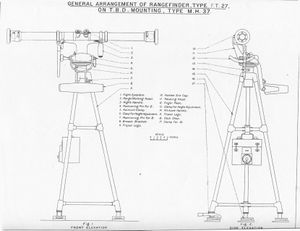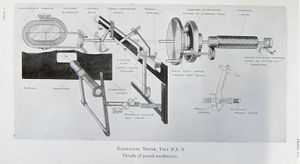Barr and Stroud Rangefinders
Barr and Stroud manufactured a large and evolving family of optical rangefinders, primarily coincidence models to several navies, notably the Royal Navy and the Japanese navy.
Early Development
The first Barr and Stroud instruments were developed in the 1890s in response to a call for rangetaking equipment meeting novel and somewhat loose and humble requirements of accuracy and maximum range. Based on their acceptance, a burgeoning relationship with the Royal Navy saw Barr and Stroud's line of instruments accepted to the near exclusion of all other types and manufacture. Over time, the number and base length of the instruments offered for each capital ship grew and grew, and the ships regarded as platforms for rangefinders grew down into the largest destroyers by the end of the war.
Part of what made Barr and Stroud a desireable supplier was that the firm's own fire control instruments were often the means by which the range cuts recorded on the devices were communicated throughout the ship.
Lessons Taken
In 1914, a Form S. 328 was introduced to track the history of every rangefinder in service, including those in store.[2]
In July 1914, rangefinders from King Edward VII and King George V which had been put badly out of calibration by the shock of heavy firing were ordered to be exchanged for new ones, and the old ones were to be examined by the manufacturer to determine what vulnerability had produced this maladjustment.[3]
The Royal Navy ultimately decided that the F.Q. type rangefinders were superior to the F.T. types;[4] By 1923, however, the F.X. types were judged the best for naval service, owing to their superior performance in low light due to their large optics. They were assumed to be slightly less accurate than F.T. equipment of the same base length, but this was of secondary consideration.[5]
Also in 1923, the Royal Navy dropped the idea of further use of stereoscopic rangefinders for low-angle use. The only two presently aboard ships were a 30 foot model in Warspite and a 9-fot one in Delhi. It was also decided in 1923 to drop the "low power" magnification of 16x in future R.F. manufacture.[6]
Maintenance and Use
Astonishingly, in 1915, just two men were charged with working with the Grand Fleet's rangefinders – one in Cyclops at Longhope and another in Tyne at Rosyth. Ships requiring their services were instructed to signal those ships directly.[7]
Nomenclature
Barr and Stroud's rangefinders, their mountings and associated appliances had an arcane naming scheme. Each had a two letter prefix and a numeric suffix. The first letter generally indicated the type of device ("F" for rangefinder, "M" for mounting, etc), and the second letter the basic sub-type or design principle. The numbers seemed to reflect finer differences.
Telescopes
Some larger rangefinder mountings could accommodate a gun sighting telescope to assist in finding the target to be trained upon. By 1924 or 1928, the following patterns of telescopes were to be used:[8]
- Flotilla leaders and destroyers: Pattern 327
- Larger ships: Pattern 328
Rangefinder Models
The rangefinder designations were all prefaced by "F" to indicate rangefinder, followed by "A", "Q", "T", or "X" to indicate basic design, and finally a numeric code to indicate model.
Most rangefinders had a "finder" scope for help in locating the target. This was generally a small telescope of lower magnification and larger field than the RF itself. On R.F.s intended for individual use, these were generally integral. On small RFs, this might just be an open sight. On larger models, they would be separate items, rigidly affixed in some manner to the mounting for use by another operator, typically the trainer. They would not follow the R.F. in pitch. On turret RFs, this was a periscope. [9]
Ivory scales for all but F.Q., P.O.D. adjustment, universal couplings, [10][TO BE CONTINUED - TONE]
F.A. 2
Baselength of 4.5ft, focused by the eye lens.[11]
Its lowest reading was 750yds, mag 26.[12]
Scale can be illuminated at night by a light off a reflector, and is focusable by moving eye lens. [13]
The finder was viewed through the lower concave half of the left eyepiece. The upper half showed the scale. Whole objective could slide back and forth to adjust for distance between user's eyes. Focussing of scale and finder was joint.[14]
The device had an astigmatiser that was moved into or out of position by a slider on the lower right hand side of the rangefinder.[15]
The working head affected the upper field (right objective). When the upper is to the right of lower, the range is more than that indicated by the scale. The guide, then, was that working the head was moving the top field in the same direction.[16]
It had a single, wide range working head.[17]
The model was still in use afloat in 1921.[18]
F.Q. 2
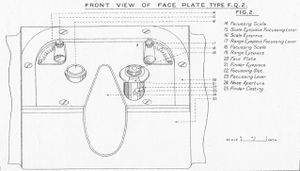
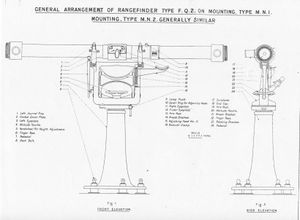
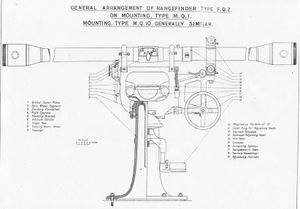
The F.Q. 2 was a notable rangefinder in the years 1906-1916, as it was the model being delivered for ships such as Dreadnought. It continued in service well into the 1920s, but by then would be relegated to secondary applications in the largest vessels.
It was manufactured in baselengths of 2m, 9ft, 12ft:[22]
- 2m lowest reading 1000yds, mag 28.[23] This length was also offered with mag 20.[24]
- 9ft, 1000yds, mag 28 or 20
- 12ft mag 20, 2000 yds
By 1921, all lengths also supported mag 16.[25]
Early 9-foot models evaluated in America around 1911 may have had a fixed magnification of 30 power in a field of 1.5 degrees, with a finder of 10 power and 4 degree field.[26] By 1924 or so, 9ft F.Q. 2s had magnifications of 15, 20 and 28, selectable.[27]
The scale could be illuminated at night by a light off a reflector, and is focusable, like the range eyepiece, by a scaled lever near the lens.[28] The scale was a spiral one etched on a strips of non-transparent celluloid wrapped on a metal drum, illuminated on the face.(p90)
A finder was located right under the right eyepiece. The range eyepiece looked 45 degrees down, but the finder looked straight down and was focussed by a small nub on its eyepiece shaft.[29] Finder looked through the scale illumination window. a small circle in the eyepiece, when placed over the target, put it in the RF view.[30]
The rangefinder had internal astigmatiser lenses that were moved into or out of position by a slider on the lower right hand side of the rangefinder.[31]
The working head affected the lower field (left objective). When the lower is to the left of upper, the range is more than that indicated by the scale. The guide, then, was that working the head was moving the lower field in the same direction.[32]
A 9ft example with uniform scale gear is found in a photo in "Range and Vision", p.92. A 2m baselength model is shown in "Range and Vision", p. 53.
There was a high speed and a low speed working head.[33]
The 9ft and 12ft models (at least) were still in use afloat in 1921.[34]
F.Q. 10
Baselength 15ft, in service afloat in 1921. It was described as being a combination of the optics of model F.Q. 2 and the dimensions of an F.T. 24.[35]
F.T. 1
Baselength of 80cm.
There are photos of this in "Range and Vision" p58, 59
F.T. 4
Baselength of 80cm.[36] Lowest reading 250yds, mag 14.[37]
The scale can be illuminated at night by a light off a reflector, and is focusable by internal adjustment (not generally needed). Scale can be read through illuminating window, as well.[38]
Its finder was a small collimator located over the right eyepiece, easy to look into without much head movement.[39]
The rangefinder had internal astigmatiser lenses that were moved into or out of position by a lever located on the left handle.[40]
The single working head was located near the right handle.[41]
The working head affected the lower field (right objective). When the lower is to the right of upper, the range is more than that indicated by the scale. The working head moved the lower field in the same direction.[42]
The model was still in use afloat in 1921.[43]
F.T. 6
Baselength 12ft. A photo from circa 1911 is in "Range and Vision" p. 78
F.T. 8

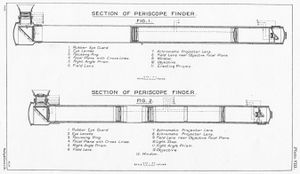
Baselength 9ft, 20 mag, focussed by moving eye lens plus the field lens.[46] variant 28 mag focused by moving eye plus field [47]
variant having both 20 and 28 power [48]
Lowest reading 1000yds[49]
Scale is illuminated a light (integral?). No means of direct daylight illumination, and is focusable by moving eye lens [50]
As this device was adjusted by a separate operator, the finder was a tall periscope of adjustable height of 2.5 power "of large field" affixed to the mounting. Different head-pieces made it work whether trainer sat with his back to the target or stood facing it. The eyepiece had a focussing ring. [51]
The rangefinder had internal astigmatiser lenses that were moved into or out of position by a slider on the lower right hand side of the rangefinder.[52]
The working head was located on top of the rangefinder on the right side, so the rangetaker's right hand could rest comfortably atop the device as he worked. [53]
The working head affected the upper field (right objective). When the upper is to the right of lower, the range is more than that indicated by the scale. The working head worked backwards; it moved the upper field in the opposite direction.[54]
It had a single, wide range working head [55]
The model was still in use afloat in 1921.[56]
F.T. 13
15 foot in turret mounting, photo in "Range and Vision" p. 93
F.T. 17
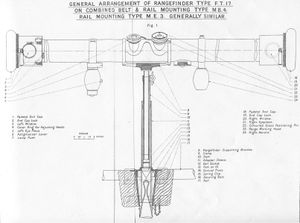
Baselengths of 66cm and 80cm.[58] Left lens is bottom in erect models.[59]
Both models lowest reading 250yds, mag 14.[60]
17 mag focused by moving eye plus field [61]
No step prism needed as in F.Q. 2, as vertical difference between beams is slight [62]
Scale is read by daylight through a window (some have lenses to concentrate light) or by a light at night, and is focusable by internal adjustment (not generally needed) [63]
The finder was a simple, small collimator with crosshairs located above the right eyepiece.[64]
The rangefinder had internal astigmatiser lenses that were moved into or out of position by a lever located on the left handle.[65]
The working head was located near the right handle.[66]
The working head affected the lower field (right objective). When the lower is to the right of upper, the range is more than that indicated by the scale. The working head moved the lower field in the same direction.[67]
It could be used with an M.B. 4 mounting.[68]
The model was still in use afloat in 1921.[69]
F.T. 23
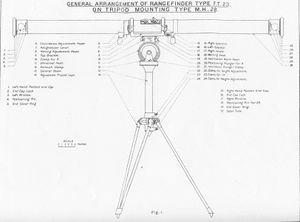
Baselength 2m, upper image inverted.[71] 25 mag focused by moving eye plus field.[72]
Lowest reading 900yds, mag 25 [73]
Scale read by small telescope with concave eyepiece as in F.Q. 2, focused by moving the whole. read by daylight (lens focuses light and external reading) or external light at night [74]
The finder was a simple, small collimator with crosshairs located above the right eyepiece.[75]
The rangefinder had internal astigmatiser lenses near the objective lenses that were moved into or out of position by a lever located on the left handle.[76]
The working head was located on top of the rangefinder on the right side, so the rangetaker's right hand could rest comfortably atop the device as he worked. [77]
The working head affected the upper field (right objective). When the upper is to the right of lower, the range is more than that indicated by the scale. The working head worked backwards; the upper partial image moved in the opposite direction.[78]
The model was still in use afloat in 1921.[79]
F.T. 24
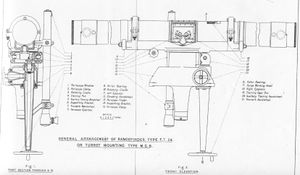
Baselengthds of 9 and 15 feet. [81] 20 mag, focused by moving eye lens plus the field lens.[82] Variant 28 mag focused by moving eye plus field [83]
9ft lowest reading 1000yds @ mag 28, 2000yds @mag20 15ft 2000yds @ either mag [84]
Variant with swappable 20 and 28 mag [85]
Scale is illuminated a light at night, and is focusable by moving eye lens [86]
As this device was adjusted by a separate operator, the finder was a tall periscope of adjustable height of 2.5 power "of large field" affixed to the mounting. Different head-pieces made it work whether trainer sat with his back to the target or stood facing it. The eyepiece had a focussing ring. [87]
The rangefinder had internal astigmatiser lenses that were moved into or out of position by a slider on the lower right hand side of the rangefinder.[88]
The working head was located on top of the rangefinder on the right side, so the rangetaker's right hand could rest comfortably atop the device as he worked. [89]
The working head affected the lower field (left objective). When the lower is to the left of upper, the range is more than that indicated by the scale. The guide, then, was that working the head was moving the lower field in the same direction.[90]
It had a single, wide range working head [91]
In late 1915, a Gunnery and Torpedo Order noted a lack of stiffness in the F.T. 24 due to its weight being greater than the F.T. 8's. All mountings were to be provided additional stays to help reduce vibration.[92]
The model was still in use afloat in 1921.[93]
F.T. 25
Baselengths of 9 and 15 feet. Erect image. Right lens is bottom. Prisms larger than in F.T. 17 and F.T. 27 [95] 20 mag, focused by moving eye lens plus the field lens.[96]
Both models lowest reading 2000yds, mag 20 [97]
Scale is illuminated by a light at night, and is focusable by moving eye lens [98]
As these were mounted within the Gun Control Tower they had no separate finder. [99]
The rangefinder had internal astigmatiser lenses that were moved into or out of position by a slider on the lower right hand side of the rangefinder.[100]
The working head was located on top of the rangefinder on the right side, so the rangetaker's right hand could rest comfortably atop the device as he worked. [101]
The working head affected the lower field (left objective). When the lower is to the left of upper, the range is more than that indicated by the scale. The working head was "backwards", and moved the lower field in the opposite direction.[102]
It had a single, wide range working head. [103]
The model was still in use afloat in 1921.[104]
F.T. 27
The F.T. 27 was a compact, single observer rangefinder of 1m or 80cm base length, and was manufactured in great numbers, often for use on land. It could be operated in hand-held manner or affixed to a tripod mounting.
All models lowest reading 250yds, mag 14.[106]
No step prism needed as in F.Q. 2, as vertical difference between beams is slight.[107]
In 80cm, where upper is inverted, lower erect.[108] It seems that the 1m model never had an inverted upper.[Inference]
Left lens is bottom in erect models.[109]
14 mag focused by moving eye plus field.[110]
Scale is read by daylight through a window (some have lenses to concentrate light) or by a light at night, and is focusable by internal adjustment (not generally needed).[111]
The finder on those with an erect upper image was a simple, small collimator with crosshairs located above the right eyepiece. Those 80cm models with an inverted upper had no finder, as they were intended for "shore use".[112]
The rangefinder had internal astigmatiser lenses near the objective lenses that were moved into or out of position by a lever located on the left handle.(p87-88)
The working head was located near the right handle.(p88-89)
The working head affected the lower field (right objective). When the lower is to the right of upper, the range is more than that indicated by the scale. The working head moved the lower field in the same direction.(p92)
It could be used with an M.B. 4 (with or without the lower portion of an M.B. 6) or an M.B. 7 mounting. On destroyers, it might be on an M.H. 37 tripod mounting.(p160)
The model was still in use afloat in 1921.[113]
F.T. 28
Intended for anti-aircraft ranging.(p76)
Baselength 1m "eyepiece arranged trunnionally so as to facilitate observation upon aircraft" (p64)
Lowest reading 800yds, mag 14.(p157)
No scale eyepiece, but can be read through a window similar to the F.T. 27. There is a separate range scale at the trunnion head of the mounting. No provision for night lighting (p76)
Could be placed, vertically on M.T. 3 and M.T. 4. The finder was a short telescope that could be adjusted in pitch and looked downward into a prism which would cast its gaze skyward without straining the neck. The image in the finder was erect. A focussing ring was on the eyepiece.(p81, plate 9)
There was no astigmatiser.(p88)
The working head was located on the mounting, reaching the rangefinder over a universal coupling (p89)
The working head affected the lower field (right objective). When the lower is to the right of upper, the range is more than that indicated by the scale. The working head worked backward; the lower partial image moved in the opposite direction.(p92-93)
TODO: photo on M.T. 4 aboard Undaunted in "Range and Vision" p82 and photo on M.T. 4 in "Range and Vision" p83
In the second half of 1914, 1-metre, erect image examples were ordered for ships with H.A. guns, with supplies commencing in early 1915. In March, this model was tested against a 2-metre inverted image model as well as a 66-cm inverted image model and was judged superior. The first produced read true range only, but a later modification allowed horizontal range to be read in addition.[115]
The model was still in use afloat in 1921.[116]
F.T. 29
Intended for use in high-angle anti-aircraft fire,(p76) the F.T. 29 on the M.T. 6 mounting would become the Royal Navy's standard anti-aircraft rangefinder system well into the 1920s.
Baselength 2m with an "eyepiece arranged trunnionally so as to facilitate observation upon aircraft".(p64)
14 mag focused by moving eye plus field.(p72)
Lowest reading 800yds, mag 14.(p157)
No scale eyepiece, but can be read through a window similar to the F.T. 27. There is a separate range scale at the trunnion head of the mounting. No provision for night lighting.(p76)
Could be placed on M.T. 6. The man elevating the trunnion faced the rangetaker and not the target as in the F.T. 28. The finder with crosswires was mounted on the trunnion and did not require gearing and prism as in the F.T. 28. The eyepiece was on the trunnion axis and so did not change position with elevation. Prisms within the finder altered the view upward 90 degrees. A selector switch swapped objective lenses to offer 3 mag and field of 14 degrees or 8 mags and field of 5.25 degrees. A focussing ring was on the eyepiece.(p82, plate 10)
The rangefinder had internal astigmatiser lenses near the objective lenses that were moved into or out of position by a lever located on the left handle.(p87-88)
The working head was located on the mounting, reaching the rangefinder over a universal coupling (p89)
The working head affected the lower field (right objective). When the lower is to the right of upper, the range is more than that indicated by the scale. The working head moved the lower field in the same direction.(p92)
Early in 1916, an erect image model was made and tested in July 1916. These read true range and horizontal range and were ordered and supplied on M.T. 6 mountings to capital ships and light cruisers at the end of 1916 and early 1917. Proposals to add a height-finder were made in January, 1917, and these would appear in the M.T. 10 mounting.[118]
The model was still in widespread use afloat in 1921.[119]
F.T. 32
Baselength 1m, mag 14. It was in service in 1921.[120]
F.T. 36
The only information I have on this device is that it was available in 80cm base length. It was probably very similar to the F.T. 27 and F.T. 37, and was compatible with the M.B. 4 and M.E. 6 mountings. There has to be a slim chance that the "36" is an error, and that "37" was somehow intended.[121]
F.T. 37
It is unknown when this device came into service. It is very similar to the F.T. 27, this device was available in an 80 cm base length and possibly also in 1m. The editor owns three -- one complete with its storage box, which also contains an M.B. 4 and M.E. 6 mounting. The M.E. 6 mounting is a very heavy piece of metal! A bill of materials in the box indicates that it is for an F.T. 36, though the outer stamp indicates F.T. 37. The F.T. 37's minimum convergence distance is 250 yards. It appears that its scale illumination is to be provided by a small electric lamp, as several bulbs are packed neatly in the box and the device lacks the handy flip-up cover found on most (all?) F.T. 27s. The bill of material indicates 2 volt accumulators (batteries) would be supplied in the box.
The F.T. 37 had rubber masks to comfortably receive the rangetaker's face as he peered through it.
F.X. 1
The upper field came from the right hand objective.(p155) The base length was 22 feet, and 28 mag, lowest reading 3000 yards (p. 157)
F.X. 2
In October, 1917, a total of 71 30-foot and 24 25-foot rangefinders and mountings were ordered, but none delivered before the end of the war. They incorporated a reversion to the F.Q. type of coincidence, which had proven superior to that in the F.T. mechanism, offered improved illumination of the image and proved less susceptible to changes in temperature.[122]
A pair of these in 15- and 30-foot base lengths were among fifteen rangefinders tested in 1921 at Fort Cumberland.[123] in "Range and Vision" p96 turret mountable
Baselengths of 15, 25 and 30ft were in service afloat in 1921.[124]
The lowest reading of the 15ft model was 2,000 yards. The 30ft model's lowest reading was 3,000 yards.[125]
The F.X. 2 could be used with any of these types of periscope finders: C.E. 10 through C.E. 16.[126]
F.X. 3
in "Range and Vision" p96 turret mountable
F.G. 4
Three of these stereoscopic instruments, in 15- and 30-foot base lengths and with Gridmark and Wandermark variations were among fifteen rangefinders tested in 1921 at Fort Cumberland.[127]
U.B. 3
One of these, in 12-foot base length was among fifteen rangefinders tested in 1921 at Fort Cumberland.[128]
U.B. 4
These were discussed in an 1924 Admiralty Fleet Order. They employed an M.T. 14 mounting and could work with Evershed gear.[129]
Rangefinder Mountings
By 1918, the traversing type of mounting was viewed as one which greatly reduced the efficiency of the rangefinder.[130]
M.B. 4
The M.B. 4 was suitable for the F.T. 17, F.T. 27, F.T. 36 and F.T. 37 RFs, and was called a "Belt and Rail" mounting, appropriate for navigational purposes. It was a stem of adjustable length that could receive the R.F.'s supporting bracket at the top and the lower end would engage either a socket on a belt with shoulder straps worn by the rangetaker or a socket that could be easily mounted on any suitable bridge railing. (p160, plate 45 fig 1)
M.B. 7
This was a belt mounting for the 1m F.T. 27s only, for navigational applications. It was similar to the M.B. 4, but it engaged the R.F.'s journal rings was not convertible to a railing mount.(p161)
M.E. 3
This was a rail mounting for the F.T. 4,[132] suitable for navigational purposes.
It was generally similar in appearance to the M.B. 4, pictured above.
M.E. 6
This was not a full mounting, but simply the lower rail mounting socket to be combined with the top stem of an M.B. 4, suitable for navigational purposes. It would be used for an 80cm F.T. 27.(p161)
M.G. 3

A turret mounting for an F.T. 8 rangefinder.
The upper portion was a rotating bracket that supported the rangefinder in 2 bearings. The rotating bracket rotated about a vertical lower shaft that could be attached to either side of the turret's longitudinal bulkhead. A trainer's hand wheel in a horizontal plane located where the trainer could look through the periscopic finder could drive the rangefinder 5 degrees to either side of the mean facing. The rangetaker had a bicycle saddle seat attached to the turret back or bulkhead as well as a second hand wheel that could be used to train the rangefinder. (p161-162, plate 46 figs1-2)
M.G. 5
M.G. 8
A turret mounting for an F.T. 24 or F.T. 25 rangefinder.
In almost all respects, it resembled the M.G. 3 except as follows. It featured an elevating handwheel similar to the (rangetaker's?) training gear, situated near the rangetaker's left hand which could drive the rangefinder between 5 degrees depression and 10 degrees elevation. Alternatively, an altitude handle could be used for this purpose, but it is not clear whether they were both installed on a given device. Additionally, the rangetaker was provided a convenient footrest.(p162, plate 47 figs1-2)
M.G. 10
A turret mounting for an F.T. 24 rangefinder.[135]
M.G. 11
A turret mounting for an F.T. 24 rangefinder.
In almost all respects, it resembled the M.G. 3 except as follows. The rotating bracket for the rangefinder was stronger than before, as the F.T. 24 was heavier than the F.T. 8 device. It featured the same elevation fittings as the M.G. 8. Unlike the M.G. 8, the rangetaker's seat was atop a tripod stand.(p163)
M.G. 13
A turret mounting for the 30ft F.X. 2. The range-taker (only) had a bicycle-type seat with a ladder by which to reach it. Adjustable footrests were bolted to the side of the ladder. The range-taker had an auxiliary training wheel to his right. A C.E. 10 periscope finder was clamped to the cradle.[136]
M.G. 14
A turret mounting for the 30ft F.X. 2 which was generally similar to the M.G. 13, but a seat was provided for the trainer as well as the range-taker. It used a C.E. 16 periscope finder.[137]
M.G. 15
A turret mounting for the 30ft F.X. 2 in Lion and {UK-PrincessRoyal}} which was generally similar to the M.G. 13 and M.G. 14. It lacked an auxiliary training wheel. Both range-taker and trainer had seats. It could use a C.E. 15 or C.E. 13 periscope finder.[138]
M.G. 16
A turret mounting generally similar to M.G. 15, it was used in the rear of the G.C.T. of Repulse and Renown. It lacked seats for range-taker and trainer, and also lacked a periscope finder.[139]
M.G. 17
M.H. 28
A tripod mounting with spike shoes and adjustable height for an F.T. 23 rangefinder, suitable for navigational purposes.
It had the means to "incline" (or roll the rangefinder from the rangetaker's perspective) through a number of intermediate positions between having the rangefinder horizontal or completely vertical in either direction. Finer adjustments in inclination were possible using a worm driven by a wingnut.
It could be trained in azimuth by using the handles on the rangefinder, but a clamp was available to lock the azimuth if desired. The rangefinder could also elevate in its bearings. It was also able to rotate in elevation when inclined at any angle.(p163-164, plate 48 fig 1)
M.H. 37
A fixed tripod mounting of adjustable height for an F.T. 27 rangefinder, suitable to be clamped to a deck. The rangetaker could train the device by rotating with it and pressing against a breast bracket. The azimuth could be clamped if desired. An altitude handle allowed the user to elevate the rangefinder in its bearings, the left one of which had a clamp.
It had the means to "incline" (or roll the rangefinder from the rangetaker's perspective) through a number of intermediate positions between having the rangefinder horizontal or completely vertical in either direction. Finer adjustments in inclination were possible using a worm driven by a wingnut.
It could be trained in azimuth by using the handles on the rangefinder, but a clamp was available to lock the azimuth if desired. The rangefinder could also elevate in its bearings. It was also able to rotate in elevation when inclined at any angle.(p164, plate 49 fig 1-2)
M.J. 1
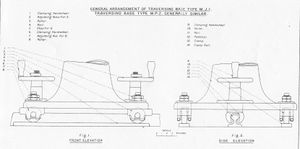
A traversing mounting for an F.Q. 2 rangefinder which could could be easily moved across the beam of the supporting platform, depending on the bearing of the enemy. It was otherwise quite similar to the non-traversing M.N. 1 mounting. Four rollers at the corners rode on a pair of flat rails, and a central bulbous railing could be clamped onto by a pair of handwheels in order to fix it in position.
Explicit warning was made that the mounting should be locked when not being moved to prevent it going wild.(p164, plate 50 fig 1-2)
M.J. 2
A traversing mounting for an F.A. 2 rangefinder which could could be easily moved across the beam of the supporting platform, depending on the bearing of the enemy. It was otherwise quite similar to the non-traversing M.N. 2 mounting.
The traversing mechanism was much like the M.J. 1, except that a single large handwheel was sufficient to clamp it in place.(p165)
M.L. 10
Compatible with an F.T. 8 or F.T. 24 in a turret mounting.[143]
M.L. 11
Compatible with an F.T. 24 in a turret mounting.[144]
M.L. 12
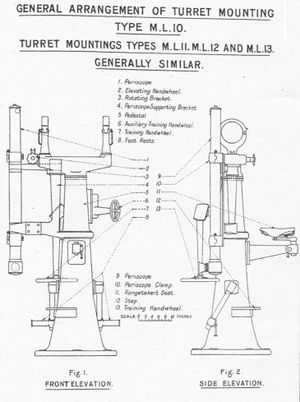
These were turret mountings for F.T. 8 and F.T. 24 rangefinders, generally similar to the M.G. mountings, except that the upper bracket sat on a vertical shaft which rotated against a supporting pedestal. The training gear was similar to the M.G. 11's and the two training handwheels similar to the M.G. 3's. The elevating gear and altitude handle resembled the M.G. 8's. The rangetaker's seat was carried on a bracket connected to the pedestal, and he enjoyed a set of adjustable foot rests.(p165, plate 51)
By 1921, they were described as being for F.T. 24 (only) in a turret mounting.[146]
M.L. 13
These were turret mountings for F.T. 8 and F.T. 24 rangefinders, generally similar to the M.L. 10, except that the rotating bracket was more similar to that in the M.G. 3.(p165)
M.N. 1

A fixed mounting for the F.Q. 2 rangefinder. Primarily a pedestal bolted to the deck with wooden or rubber washers to reduce vibration, the rangefinder could move in azimuth on a rotating bracket.
A breast bracket could either be swung to a stowage position in the bracket fork or adjusted to any of three positions for use, and an arm rest near the right hand could be adjusted in height to allow the rangetaker some comfort. Azimuth adjustment was simply effected by undoing a clamp at the top of the pedestal and exerting pressure on the breast bracket. On the left side, an altitude handle with a finger rest permitted the rangefinder to be rotated in its bearings to the desired elevation.
A handwheel at the base of the rotating bracket allowed the rangefinder to be raised or lowered to suit the height of the rangetaker.(p165-166, plate 52 fig1-2)
M.N. 2
This was generally similar to the M.N. 1, but accommodated a lighter and smaller F.A. 2 rangefinder and so was itself also of lighter construction. Its breast bracket did not lock into different positions — it was either stowed or deployed.(p166)
M.P. 2
This was a traversing mounting for an F.Q. 2 rangefinder. The traversing portion resembled the M.J. 1's, and the pedestal resembled that of the fixed M.Q. 1 mounting.(p166)
M.P. 3
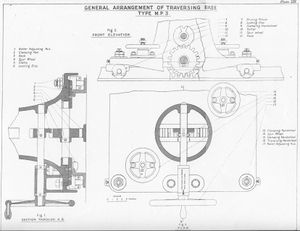
This was a traversing mounting for an F.Q. 2 rangefinder. The pedestal resembled that of the fixed M.Q. 1 mounting. The traversing base had four rollers, but the rails were Z shaped in section, and they also functioned as the clamping rails, unlike the M.J. models. Two clamping handwheels were provided, one for each rail.
The traversing function was no longer free-wheeling, but a pinion under the base engaged a toothed rack between the Z rails. A detachable handwheel drove the traversal.(p167, plate 53)
M.Q. 1
This was a fixed pedestal mounting for an F.Q. 2 rangefinder. The rotating bracket had a gimbaled compass with correcting spheres and an adjustable arm rest.
Training was now effected by a handwheel and not merely by breast plates. Later models of this mounting also had an azimuth scale. Elevation was worked by a handwheel which could be disengaged by a small lever for direct adjustment by a removable altitude handle.
The provision of a training handwheel allowed the rangetaker to have a seat with footrests, adjustable in height and leg length. The trainer's telescope could be mounted above or below the rangefinder, and calibrated to conformity by a worm on its left.(p167-168,plate 54)
M.Q. 8
The Annual Report of the Torpedo School, 1918 mentions this pedestal mounting as the model in the T.C.T.s of the Iron Duke class.[149]
M.Q. 10
This was a fixed pedestal mounting, similar to an M.Q. 1, but for the heavier F.T. 24 rangefinder. The trainer's telescope was replaced by a periscope.(p168)
These were in the T.C.T.s of Revenge, Queen Elizabeth and King George V classes, as well as Glorious and Canada. Courageous, Repulse and Renown were to receive them with different cross brackets.[150]
M.Q. 11
This was a fixed pedestal mounting capable of hosting some model of 15-foot rangefinder, as was done aloft on Furious.[151]
M.V. 3
The Annual Report of the Torpedo School, 1918 mentions this pedestal mounting as the model in Tiger's TCT.[152]
M.V. 5
For the 15ft F.X. 2 in the rotating light canopy atop the T.C.T. of H.M.S. Hood. Seats were provided for the range-taker, trainer, hand-follower and a communication attendant. The range-taker had a handwheel by which the RF could train 5° to either side of the canopy centerline. This was independent of the canopy training, which the training number, who sat on the front side of the rangefinder, controlled. The mounting included Evershed gear and mountings for data receivers and indicators.[153]
M.T. 3
This was a high-angle, anti-aircraft mounting for the F.T. 28 rangefinder. The base was a tripod which could be clamped onto the deck.
A trunnion bracket on the rotating head carried the rangefinder, working head and scale gear. The scale gear was housed in a circular case mounted on the trunnion with a white celluloid range scale visible through a window. The range was visible in red, and gunsight ranges suitable for a 3-in, 20-cwt gun were indicated on the scale by a black index line on a plum bob pendulum. In this way, the elevation of the trunnion was telling the device the altitude the target was at. The pendulum could be locked down, if desired.
Elevation was dialed on by a handwheel, and the vertically-mounted rangefinder could be adjusted for targets from 0 to 80 degrees of elevation. Training was to be accomplished by the rangetaker, by a handwheel near his left hand. Both azimuth and elevation were altered through friction slip-bearings, a design which permitted gross adjustments to be quickly effected by hand.
The man who adjusted the rangefinder in altitude had a finder with a prism to keep his sight in agreement with the rangefinder's orientation, but without requiring him to crane his neck. An open sight was also available.(p168-169)
The device resembled the M.T. 4, pictured below.
M.T. 4
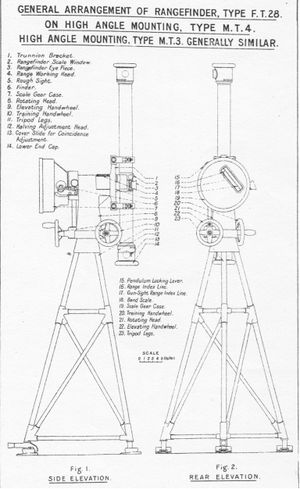
This was a high-angle, anti-aircraft mounting for the F.T. 28 rangefinder. It was similar to the M.T. 3, but the tripod legs were more sturdy.(p168-169, plate 55)
M.T. 6
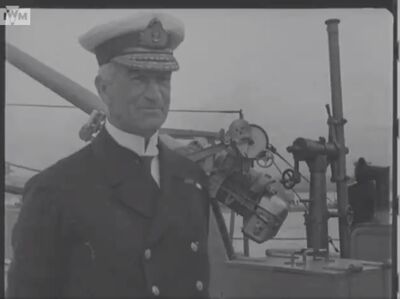
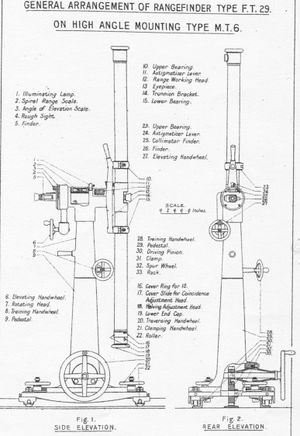
This was a high-angle, anti-aircraft mounting for the F.T. 29 2m rangefinder. It was similar to the M.T. 4, except as follows.
Rather than a tripod, the design used a pedestal which was compatible with traversing dollies as in the M.P. 3 mounting. The range scale was a spiral with a traveling index, and no means to generate a gun sight range was provided. Instead, the trunnion did have a scale that indicated its elevation angle.
The finder did not have prisms, but a simple 90 degree turn skyward. It had 2 powers, selected by a lever (see F.T. 29).(p169, plate 56)
M.T. 9
By 1921, the M.T. 9 was used in older light cruisers (prior to Ceres class) with a 1m F.T. 28 for high-angle work. Later cruisers employed 2m F.T. 29s on M.T. 10s. It is unclear how it differed from the M.T. 4 mounting, whose use is conspicuously not noted in a 1921 rangefinder reference.[157]
M.T. 10
Probably similar to the M.T. 6, the M.T. 10 was for high angle rangefinding and added a height finder to the existing horizontal and true range capabilities of the M.T. 6 and its rangefinder. It was seemingly proposed in January, 1917, and was the type being supplied to work with the 2m F.T. 29 by 1919.[158]
By 1921, it became apparent that the M.T. 10 was being used in cruisers and the M.T. 6 was in capital ships.[159]
M.T. 14
These were discussed in an 1924 Admiralty Fleet Order and were Pattern number 7084. They could work with Evershed gear and a U.B. 4 rangefinder.[160]
M.W. 1
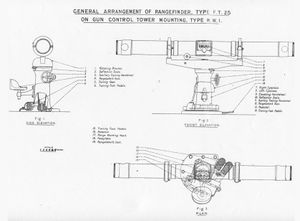
This was a mounting for the F.T. 24 and F.T. 25 rangefinders, suitable for use in a Gun Control Tower.
Its training gear was similar to the M.G. 11's, but rather than handwheels, a pair of pedals were worked, with each press of either pedal changing the azimuth by 0.25 degrees. A deflection scale and index on the right hand side indicated up to 100 knots of deflection to either side of the mean. The rangetaker had an auxiliary training handwheel.
Elevation arrangements were similar to those in M.G. 8, ranging from 5 degrees depression to 10 degrees elevation. The rangetaker had a seat on a bracket attached to the pedestal.(p170, plate 57)
Associated Equipment
C.E. 1
A finder periscope of 6 power suitable for use from a Torpedo Control Tower, adapted so that the trainer keeps his back to the target, which proved to be more space-efficient when adding 15-ft R.F.s to the T.C.T.. The narrow field of this device, however, prompted a switch to the C.E. 12, so the target could be kept while own ship rolled without so much need for manual elevation.[162]
C.E. 5
A finder periscope in which the observer faces the target. Although this was the periscope envisaged for use when adding 15-ft R.F.s to the T.C.T., there was not enough room to have the trainer stand facing the target. This prompted a switch to the C.E. 1, and soon after to the C.E. 12.[163]
C.E. 12
A finder periscope, switchable between 2.5 and 6 magnifications suitable for use from a Torpedo Control Tower, adapted so that the trainer faces backwards. It was generally preferred to the C.E. 1, as the broader field allowed the target to be kept while rolling without need for manual elevation.[164]
E.D. 1
This uniform scale autogear worked with T.L equipment to help carry ranges onward.[165]
T.L. 2
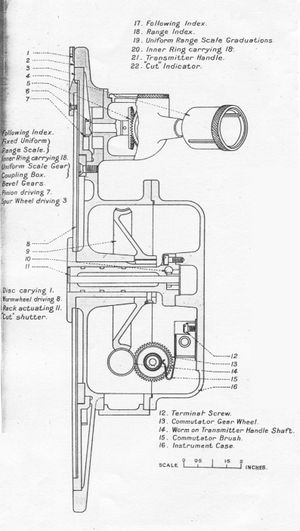
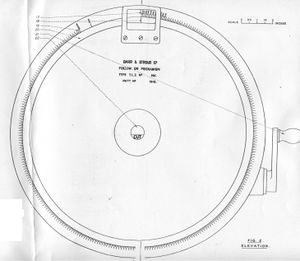
The T.L. 2 was a data transmitter device that could allow a Barr & Stroud rangefinder to transmit its range cut data to a remote location. It was a Follow-the-Pointer type device that could be attached to a compatible rangefinder to received from the rangefinder an indication of the range cut presently on the prisms.
The rotational input of the prism angle would be rectified to a linear range scale, and a dedicated operator would see the range on the R.F. indicated on a dial. This man would then use a handwheel to chase this pointer with another index and simulatneously drive a servo-motor transmitter to transmit the range in Step-by-Step fashion to a Single Range Receiver in (typically) the Transmitting Station. When the man working the rangefinder indicated he had a good "cut", the man at the T.L. device woudl press a button marked "Cut", which would variously flip open shutters at the receiver to indicate the range or illuminate a bulb. Bells or buzzers might also ring, for dramatic effect.
H.D. 3
The H.D. 3 was a Rangetaker testing apparatus to permit operators to practice against simulated stationary or moving targets.[168]
The user had an eyepiece of adjustable focus through which he could observe a target which was simply a vertical line etched on a glass plate to simulate a mast of a ship. His view of this object was through a window divided into the familiar upper-and-lower halves typical of Barr & Stroud coincidence rangefinders.
A white background was the custom, but this could be altered by daylight or artificial light by raising a flap on the back side of the device. A working head (which could be made to operate in either directionality, to simulate various rangefinders) on the right side permitted the "cut" to be adjusted and simultaneously moved a recording pencile over paper to a position indicating the cut's current imprecision. A lever on the left side allowed the operator to signal a "cut", and this caused the pencil to touch down on the paper to record the precision, and then cause the paper to advance.
The paper was marked with "allowances" and "half allowances" of angular precision suitable to the "uncertainty of observation" for the rangefinder being trained for.
A "moving target handle" permitted instructors to alter the angle of the coincidence window to present the effect of a target changing in range, to challenge the operator being trained. This prevented students from knowing that the same position of the working head produced a perfect cut. Instructors were also provided with a "pitch and roll handle", whose function was governed by which of three positions it was placed in:
- "out" caused the handle to alter the target's position side-to-side
- "mid" caused the handle to alter the target's position up and down
- "in" combined the above two functions into one
See Also
Footnotes
- ↑ Capture of a still picture appearing in a video, likely from NMM files.
- ↑ Admiralty Weekly Order No. 817 of 16 Jan, 1914.
- ↑ Admiralty Weekly Order No. 93 of 3 Jul, 1914.
- ↑ Progress in Naval Gunnery, 1914-1918, p. 40.
- ↑ Progress in Gunnery Material, 1922 and 1923. pp. 39-40.
- ↑ Progress in Gunnery Material, 1922 and 1923. p. 40.
- ↑ Grand Fleet Gunnery and Torpedo Orders. No. 30.
- ↑ Handbook for Naval Range-Finders and Mountings, Book I. p. 128.
- ↑ Handbook for Barr and Stroud Naval Range-Finders and Mountings. p. 76-77.
- ↑ Handbook for Barr and Stroud Naval Range-Finders and Mountings. p. 90-91.
- ↑ Handbook for Barr and Stroud Naval Range-Finders and Mountings. p. 71.
- ↑ Handbook for Barr and Stroud Naval Range-Finders and Mountings. p. 157.
- ↑ Handbook for Barr and Stroud Naval Range-Finders and Mountings. p. 73.
- ↑ Handbook for Barr and Stroud Naval Range-Finders and Mountings. p. 77.
- ↑ Handbook for Barr and Stroud Naval Range-Finders and Mountings. p. 85-86.
- ↑ Handbook for Barr and Stroud Naval Range-Finders and Mountings. p. 91.
- ↑ Handbook for Barr and Stroud Naval Range-Finders and Mountings. Plate 11.
- ↑ Handbook for Naval Range-Finders and Mountings, Book I. pp. 61-64.
- ↑ Handbook for Barr and Stroud Naval Range-Finders and Mountings. Plate 2, Fig 2.
- ↑ Handbook for Barr and Stroud Naval Range-Finders and Mountings. Plate 52.
- ↑ Handbook for Barr and Stroud Naval Range-Finders and Mountings. Plate 54.
- ↑ Handbook for Barr and Stroud Naval Range-Finders and Mountings. p. 71.
- ↑ Handbook for Barr and Stroud Naval Range-Finders and Mountings. p. 157.
- ↑ Handbook for Naval Range-Finders and Mountings, Book I. pp. 160, 161.
- ↑ Handbook for Naval Range-Finders and Mountings, Book I. pp. 160, 161.
- ↑ Description of the Barr and Stroud 9-Foot Horizontal Base Self-Contained Range Finder, Type F.Q. 2. p. 7.
- ↑ Progress in Naval Gunnery, 1922-1923 (AFM 186/259), p. 37.
- ↑ Handbook for Barr and Stroud Naval Range-Finders and Mountings. p. 73, Plate 2.
- ↑ Handbook for Barr and Stroud Naval Range-Finders and Mountings. Plate 2.
- ↑ Handbook for Barr and Stroud Naval Range-Finders and Mountings. p. 77-78.
- ↑ Handbook for Barr and Stroud Naval Range-Finders and Mountings. pp. 86-87.
- ↑ Handbook for Barr and Stroud Naval Range-Finders and Mountings. pp. 91-92.
- ↑ Handbook for Barr and Stroud Naval Range-Finders and Mountings. Plate 12.
- ↑ Handbook for Naval Range-Finders and Mountings, Book I. pp. 65-69.
- ↑ Handbook for Naval Range-Finders and Mountings, Book I. p. 94.
- ↑ Handbook for Barr and Stroud Naval Range-Finders and Mountings. p. 71.
- ↑ Handbook for Barr and Stroud Naval Range-Finders and Mountings. p. 157.
- ↑ Handbook for Barr and Stroud Naval Range-Finders and Mountings. p. 74.
- ↑ Handbook for Barr and Stroud Naval Range-Finders and Mountings. p. 78.
- ↑ Handbook for Barr and Stroud Naval Range-Finders and Mountings. pp. 86-87.
- ↑ Handbook for Barr and Stroud Naval Range-Finders and Mountings. pp. 88-89, Plate 13.
- ↑ Handbook for Barr and Stroud Naval Range-Finders and Mountings. p. 92.
- ↑ Handbook for Naval Range-Finders and Mountings, Book I. pp. 70-73.
- ↑ Handbook for Barr and Stroud Naval Range-Finders and Mountings. Plate 46.
- ↑ Handbook for Barr and Stroud Naval Range-Finders and Mountings. Plate 8
Figure 1 depicts the model for where the trainer's back faces the target. - ↑ Handbook for Barr and Stroud Naval Range-Finders and Mountings. p. 71.
- ↑ Handbook for Barr and Stroud Naval Range-Finders and Mountings. p.72.
- ↑ Handbook for Barr and Stroud Naval Range-Finders and Mountings. pp. 72-73.
- ↑ Handbook for Barr and Stroud Naval Range-Finders and Mountings. p. 157.
- ↑ Handbook for Barr and Stroud Naval Range-Finders and Mountings. pp. 74-75.
- ↑ Handbook for Barr and Stroud Naval Range-Finders and Mountings. pp. 79-80, Plate 8.
- ↑ Handbook for Barr and Stroud Naval Range-Finders and Mountings. pp. 86-87.
- ↑ Handbook for Barr and Stroud Naval Range-Finders and Mountings. pp. 88-89.
- ↑ Handbook for Barr and Stroud Naval Range-Finders and Mountings. p. 92.
- ↑ Handbook for Barr and Stroud Naval Range-Finders and Mountings. Plate 14.
- ↑ Handbook for Naval Range-Finders and Mountings, Book I. pp. 74-77.
- ↑ Handbook for Barr and Stroud Naval Range-Finders and Mountings. Plate 45.
- ↑ Handbook for Barr and Stroud Naval Range-Finders and Mountings. p. 59.
- ↑ Handbook for Barr and Stroud Naval Range-Finders and Mountings. p. 63.
- ↑ Handbook for Barr and Stroud Naval Range-Finders and Mountings. p. 157.
- ↑ Handbook for Barr and Stroud Naval Range-Finders and Mountings. p. 72.
- ↑ Handbook for Barr and Stroud Naval Range-Finders and Mountings. p. 59.
- ↑ Handbook for Barr and Stroud Naval Range-Finders and Mountings. p. 75.
- ↑ Handbook for Barr and Stroud Naval Range-Finders and Mountings. pp. 80-81.
- ↑ Handbook for Barr and Stroud Naval Range-Finders and Mountings. pp. 86-87.
- ↑ Handbook for Barr and Stroud Naval Range-Finders and Mountings. pp. 88-89.
- ↑ Handbook for Barr and Stroud Naval Range-Finders and Mountings. p. 92.
- ↑ Handbook for Barr and Stroud Naval Range-Finders and Mountings. p. 160.
- ↑ Handbook for Naval Range-Finders and Mountings, Book I. pp. 78-80.
- ↑ Handbook for Barr and Stroud Naval Range-Finders and Mountings. Plate 48.
- ↑ Handbook for Barr and Stroud Naval Range-Finders and Mountings. p. 62.
- ↑ Handbook for Barr and Stroud Naval Range-Finders and Mountings. p. 72.
- ↑ Handbook for Barr and Stroud Naval Range-Finders and Mountings. p. 157.
- ↑ Handbook for Barr and Stroud Naval Range-Finders and Mountings. p. 76.
- ↑ Handbook for Barr and Stroud Naval Range-Finders and Mountings. pp. 80-81.
- ↑ Handbook for Barr and Stroud Naval Range-Finders and Mountings. pp. 87-88.
- ↑ Handbook for Barr and Stroud Naval Range-Finders and Mountings. pp. 88-89.
- ↑ Handbook for Barr and Stroud Naval Range-Finders and Mountings. p. 92.
- ↑ Handbook for Naval Range-Finders and Mountings, Book I. pp. 81-83.
- ↑ Handbook for Barr and Stroud Naval Range-Finders and Mountings. Plate 47.
- ↑ Handbook for Barr and Stroud Naval Range-Finders and Mountings. p. 71.
- ↑ Handbook for Barr and Stroud Naval Range-Finders and Mountings. p. 71.
- ↑ Handbook for Barr and Stroud Naval Range-Finders and Mountings. p. 72.
- ↑ Handbook for Barr and Stroud Naval Range-Finders and Mountings. p. 157.
- ↑ Handbook for Barr and Stroud Naval Range-Finders and Mountings. pp. 72-73.
- ↑ Handbook for Barr and Stroud Naval Range-Finders and Mountings. pp. 74-75.
- ↑ Handbook for Barr and Stroud Naval Range-Finders and Mountings. pp. 79-80, Plate 8.
- ↑ Handbook for Barr and Stroud Naval Range-Finders and Mountings. pp. 86-87, as F.T. 8... may differ slightly.
- ↑ Handbook for Barr and Stroud Naval Range-Finders and Mountings. pp. 88-89.
- ↑ Handbook for Barr and Stroud Naval Range-Finders and Mountings. pp. 91-92.
- ↑ Handbook for Barr and Stroud Naval Range-Finders and Mountings. Plate 15 Fig 1.
- ↑ Grand Fleet Gunnery and Torpedo Orders. No. 104.
- ↑ Handbook for Naval Range-Finders and Mountings, Book I. pp. 84-87.
- ↑ Handbook for Barr and Stroud Naval Range-Finders and Mountings. Plate 57.
- ↑ Handbook for Barr and Stroud Naval Range-Finders and Mountings. p. 63.
- ↑ Handbook for Barr and Stroud Naval Range-Finders and Mountings. p. 71.
- ↑ Handbook for Barr and Stroud Naval Range-Finders and Mountings. p. 157.
- ↑ Handbook for Barr and Stroud Naval Range-Finders and Mountings. pp. 74-75.
- ↑ Handbook for Barr and Stroud Naval Range-Finders and Mountings. p. 81.
- ↑ Handbook for Barr and Stroud Naval Range-Finders and Mountings. pp. 86-87, as F.T. 8... may differ slightly.
- ↑ Handbook for Barr and Stroud Naval Range-Finders and Mountings. pp. 88-89.
- ↑ Handbook for Barr and Stroud Naval Range-Finders and Mountings. pp. 91-92.
- ↑ Handbook for Barr and Stroud Naval Range-Finders and Mountings. Plate 20(?) Fig 4.
- ↑ Handbook for Naval Range-Finders and Mountings, Book I. p. 88.
- ↑ Handbook for Barr and Stroud Naval Range-Finders and Mountings. Plate 49.
- ↑ Handbook for Barr and Stroud Naval Range-Finders and Mountings. p. 157.
- ↑ Handbook for Barr and Stroud Naval Range-Finders and Mountings. p. 59.
- ↑ Handbook for Barr and Stroud Naval Range-Finders and Mountings. p. 60.
- ↑ Handbook for Barr and Stroud Naval Range-Finders and Mountings. p. 63.
- ↑ Handbook for Barr and Stroud Naval Range-Finders and Mountings. p. 72.
- ↑ Handbook for Barr and Stroud Naval Range-Finders and Mountings. p. 75.
- ↑ Handbook for Barr and Stroud Naval Range-Finders and Mountings. pp. 80-81.
- ↑ Handbook for Naval Range-Finders and Mountings, Book I. pp. 89, 90.
- ↑ Handbook for Barr and Stroud Naval Range-Finders and Mountings. Plate 55.
- ↑ The Technical History and Index, Vol. 3, Part 23. p. 34.
- ↑ Handbook for Naval Range-Finders and Mountings, Book I. pp. 91, 92.
- ↑ Handbook for Barr and Stroud Naval Range-Finders and Mountings. Plate 56.
- ↑ The Technical History and Index, Vol. 3, Part 23. p. 34.
- ↑ Handbook for Naval Range-Finders and Mountings, Book I. p. 93.
- ↑ Handbook for Naval Range-Finders and Mountings, Book I. p. 160.
- ↑ Editor has a F.T. 37 storage box listing a F.T. 36 80cm RF and the two mountings as supplied inventory.
- ↑ The Technical History and Index, Vol. 3, Part 23. p. 33.
- ↑ Progress in Gunnery Material, 1922 and 1923. p. 39.
- ↑ Handbook for Naval Range-Finders and Mountings, Book I. p. 94.
- ↑ Handbook for Naval Range-Finders and Mountings, Book I. p. 154.
- ↑ Handbook for Naval Range-Finders and Mountings, Book I. p. 127.
- ↑ Progress in Gunnery Material, 1922 and 1923. p. 39.
- ↑ Progress in Gunnery Material, 1922 and 1923. p. 39.
- ↑ Admiralty Fleet Order 2903. (N.S./G. 13520/24.—31.10.1924.)
- ↑ Annual Report of the Torpedo School, 1918. p. 177.
- ↑ Handbook for Barr and Stroud Naval Range-Finders and Mountings. Plate 45.
- ↑ Handbook for Barr and Stroud Naval Range-Finders and Mountings. p. 161.
- ↑ Handbook for Barr and Stroud Naval Range-Finders and Mountings. Plate 46.
- ↑ Handbook for Barr and Stroud Naval Range-Finders and Mountings. Plate 47.
- ↑ Handbook for Naval Range-Finders and Mountings, Book I. pp. 114, 115.
- ↑ Handbook for Naval Range-Finders and Mountings, Book I. p. 124, Plates 73, 74.
- ↑ Handbook for Naval Range-Finders and Mountings, Book I. p. 125, Plate 75.
- ↑ Handbook for Naval Range-Finders and Mountings, Book I. p. 125, Plate 76.
- ↑ Handbook for Naval Range-Finders and Mountings, Book I. p. 126, Plates 77, 78.
- ↑ Handbook for Barr and Stroud Naval Range-Finders and Mountings. Plate 48.
- ↑ Handbook for Barr and Stroud Naval Range-Finders and Mountings. Plate 49.
- ↑ Handbook for Barr and Stroud Naval Range-Finders and Mountings. Plate 50.
- ↑ Handbook for Naval Range-Finders and Mountings, Book I. p. 116.
- ↑ Handbook for Naval Range-Finders and Mountings, Book I. p. 116.
- ↑ Handbook for Barr and Stroud Naval Range-Finders and Mountings. Plate 51.
- ↑ Handbook for Naval Range-Finders and Mountings, Book I. p. 116.
- ↑ Handbook for Barr and Stroud Naval Range-Finders and Mountings. Plate 52.
- ↑ Handbook for Barr and Stroud Naval Range-Finders and Mountings. Plate 53.
- ↑ Annual Report of the Torpedo School, 1918. p. 175.
- ↑ Annual Report of the Torpedo School, 1918. p. 175.
- ↑ Annual Report of the Torpedo School, 1918. p. 178.
- ↑ Annual Report of the Torpedo School, 1918. p. 175.
- ↑ Handbook for Naval Range-Finders and Mountings, Book I. pp. 126, 127, Plate 79.
- ↑ Handbook for Barr and Stroud Naval Range-Finders and Mountings. Plate 55.
- ↑ Still from British Pathé film.
- ↑ Handbook for Barr and Stroud Naval Range-Finders and Mountings. Plate 56.
- ↑ Handbook for Naval Range-Finders and Mountings, Book I. pp. 168-172.
- ↑ The Technical History and Index, Vol. 3, Part 23. p. 34.
- ↑ Handbook for Naval Range-Finders and Mountings, Book I. pp. 168-172.
- ↑ Admiralty Fleet Order 2903. (N.S./G. 13520/24.—31.10.1924.)
- ↑ Handbook for Barr and Stroud Naval Range-Finders and Mountings. Plate 57.
- ↑ Annual Report of the Torpedo School, 1918. p. 175.
- ↑ Annual Report of the Torpedo School, 1918. p. 175.
- ↑ Annual Report of the Torpedo School, 1918. p. 175.
- ↑ Annual Report of the Torpedo School, 1918. p. 175.
- ↑ Handbook for Barr and Stroud Naval Range-Finders and Mountings. Plate 40, Fig 1.
- ↑ Handbook for Barr and Stroud Naval Range-Finders and Mountings. Plate 40, Fig 2.
- ↑ Manual of Gunnery (Volume III) for His Majesty's Fleet, 1920. pp. 45-48.
Bibliography
- Admiralty, Gunnery Branch (1916). Handbook for Barr and Stroud Naval Range-Finders and Mountings. C.B. 269. The National Archives: ADM 186/205.
- Moss, Michael; Russell, Iain (1988). Range and Vision: The First Hundred years of Barr & Stroud. Edinburgh: Mainstream Publishing. ISBN 1851581286.
- Government Printing Office, Washington. Description of the Barr and Stroud 9-Foot Horizontal Base Self-Contained Range Finder, Type F.Q. 2, No 1905. May 18, 1911. Copy No 404 in editor's library.

